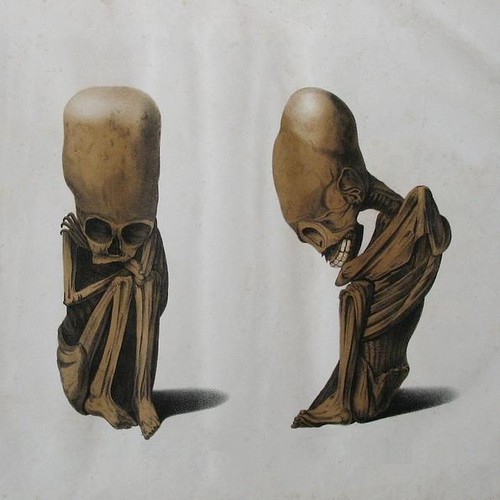"The history of nations, or of the times in which they
flourished, does not interest, simply by showing the degree
of power and culture to which they attained, and the means
by which they were able to subjugate or aggrandize those
who were ruled ; but also, by instructing us in the
progressive steps of commerce, arts, and sciences; those
mighty agents which enlarge the understanding, develop
the riches of nature, remove obstacles, and prepare a
people for the enjoyment of rational liberty." [Preface]












[click for enlarged versions - the last two images were cropped and or cleaned up and or brightened but they link through to the original images]
In the 1830s and 1840s, Peruvian museum curator Mariano Eduardo de Rivero and Swiss naturalist Dr Johann Jakob von Tschudi undertook a survey of all known relics, ruins, records, bones, artefacts and artworks relating to the pre-Columbian civilisations of Peru.
The resultant 1851 book, 'Antigüedades Peruanas', was a thorough and critical archaeological, ethnographic and anthropological review for its time, although their conclusions about, for instance, racial groupings have been superseded.
They believed that the indigenous peoples could be divided into three groups according to skull shape and anatomy - see the final image above of a mummified infant with a peculiarly elongated cranium (dolichocephaly), an appearance they (say they) saw so often in childhood skeletons that it could only be from an inherited trait and not from any form of mechanical binding or disease/nutrition state.
Their investigations in places such as the mud brick citadel at Chan Chan, near Trujillo, contributed important archaeological data to the body of research on the pre-Incan Chimú Kingdom. Both authors have sites in Chan Chan named after them. And as an extension to his Peruvian studies, Von Tschudi was responsible for the first ever publication of the 15th century Incan dramatic play, 'Apu Ollantay', described as the "most important literary work that has survived in any language indigenous to America".
I am indebted to Andrew for not only uploading a set of 62 images from 'Antigüedades Peruanas', but for making contact to pass on the link and some background information.
- An english translation of 'Antigüedades Peruanas' was released in 1853 ('Peruvian Antiquities') [but containing fewer illustrations than the original] and is available at Archive.org {direct link to a 500kb text file}. A new edition of the book was published in 2005.
- Don Mariano Eduardo de Rivero and Dr Johann Jakob von Tschudi.
- 'Apu Ollantay' at Sacred Texts. [also]
- In a couple of the above images, the jar-like ceramic objects are in fact Peruvian whistling bottles, both a (shamanistic?) musical device and a container for liquids. Curiously, a 1977 paper from the Journal of the Acoustic Society of America, 'Peruvian Whistling Bottles' [by S Garrett and G Stat] states that whistling bottles can be grouped acoustically according to ethnological group. Meaning: each of the nine pre-Columbian civilisations of Northern Peru constructed vessels that produced unique sounds characteristic for each group. [More generally: i, ii, iii]
- For the past few years the Estate of Edward Gorey has been selling a print each year from Gorey's collection of 'Antigüedades Peruanas' illustrations (a couple of them can be seen among the images at Andrew's flickr site) - this year's auction closes in a couple of weeks.
- 'Ancient Cuzco: Heartland of the Inca' by Brian S Bauer 2004 looks pretty good. [more]
- 'The Dolichocephaloids - Missing Race Of Our Human Family' by Randy Koppang. Make of this what you will.
- Chan Chan/Chimú: i, ii, iii. [flickr]
- Museo Larco.
Tidak ada komentar:
Posting Komentar